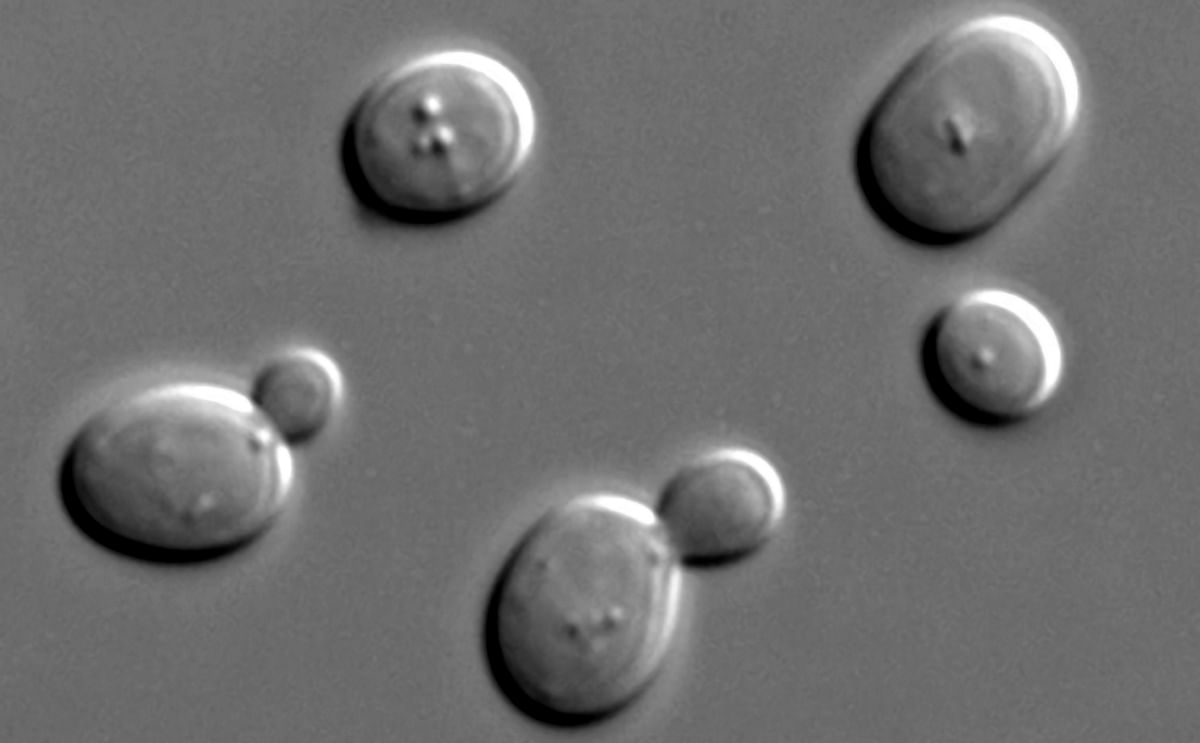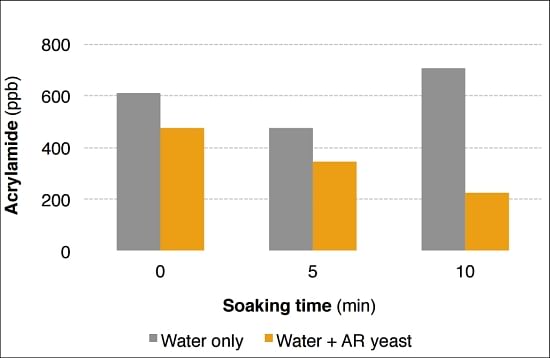Saccharomyces cerevisiae cells (commonly known and used as baker's yeast) are here seen with DIC microscopy. Renaissance Ingredients has developed and selected special (non-GMO) strains of baker's yeast that are particularly capable to degrade asparagine, one of the precursors of acrylamide in food.
Solapas principales
Special Bakers Yeast shows potential to reduce acrylamide in potato products

Renaissance Ingredients Inc. is pleased to release the results of an in-house, laboratory-scale analysis of the efficacy of its non-GMO acrylamide-reducing baker’s yeast for applications in the global potato products market.
The results showed an average 70% reduction in the presence of the carcinogen acrylamide in fried potato products after a simple application of the acrylamide-reducing yeast in a water solution during the raw potato processing phase.
With refinement, the company believes it can reach up to a 95% reduction in potato chips, fries, and crisps and other foods such as bread, snacks, cereals, and coffee. In essence, the company believes it has a practical solution to the acrylamide problem in a range of different food products.
In this proof-of-concept laboratory test, a “wash” of AR yeast in water was used to treat cut raw potatoes in order to remove the acrylamide precursor asparagine on the surface prior to deep-frying. In the test, raw russet potatoes were peeled and rinsed before being chopped into fries and blanched. The pre-cooked fries were soaked in a solution of AR yeast and water, rinsed in fresh water to remove the yeast, and then deep-fried. After only five minutes of soaking, the fries from the AR solution had substantially less acrylamide (27%) post-frying than the fries soaked in water. After ten minutes of soaking before deep-frying, AR yeast-treated fries contained 68%–71% less acrylamide, but were otherwise indistinguishable from the fries soaked in water.

Laboratory testing of Renaissance Ingredients’ acrylamide-reducing (AR) yeast on sliced raw (regular) French fries showed a 70% reduction in acrylamide after deep-frying.
In these tests, the sliced raw potatoes were soaked in a “wash” of acrylamide-reducing yeast in water for 10 minutes before being processed as normal.
The wash process with acrylamide-reducing yeast may deliver even better results when applied to thinly cut potato products with increased surface area compared to regular French fries such as shredded hash brown potatoes, shoestring French fries, and thinly sliced potato chips (crisps).
Matthew Dahabieh, President of Renaissance Ingredients:
“We are very pleased with the excellent results achieved in our proof-of-concept testing of our AR yeast in fried potato products. These results confirm the ability of our AR yeast to substantially and easily reduce acrylamide in French fries and potato chips, simply by soaking raw or precooked potatoes in an AR yeast and water solution for just a few minutes.”
“We are confident that we will be able to collaborate with industry partners to apply our AR yeast to a variety of potato products to deliver significant reductions in acrylamide using a method that is robust, consistent and, most importantly, minimally disruptive.”
“Our results confirm that our AR yeast soaking process works quickly to consistently deliver exceptional reductions of acrylamide in French fries and other fried processed potato products. Additionally, our process maintains the quality and sensory attributes of the product and can be easily adapted to current industrial potato processing practices.”
“We are now looking to demonstrate this efficacy in pilot-scale trials by working closely with interested industry partners.”
AR yeast applications: baked goods, potato products, snack foods and coffee
Renaissance Ingredients’ AR yeast strains are traditional baker’s yeast with an accelerated natural ability to consume the amino acid sparagines, the precursor to acrylamide. In foods where yeast has always been used as an ingredient, such as baked goods, AR yeast can seamlessly replace conventional baker’s yeast with no disruption to the baking process. Importantly, AR yeast also can be used in foods in which yeast is not normally an ingredient. Renaissance Ingredients has conducted numerous successful studies on the feasibility of using AR yeast in novel ways for foods containing yeast extract, chemically leavened foods, or foods exposed to soaking steps during processing.
“Our in-house studies highlight the versatility and efficacy of our AR yeast in reducing acrylamide not only in potato products but also in baked goods and toast, snack foods, cereal, and coffee,” adds Dahabieh.
Bread and toast study shows 80% reduction with no change in baking process
Previously the company announced the results of its in-house, laboratory-scale trial of its AR baker’s yeast for the bread and baked goods market. In this test, using AR baker’s yeast instead of conventional baker’s yeast reduced the acrylamide in white and whole wheat bread and toast by an average of 80%.
This reduction was observed in untoasted bread, as well as across three degrees of toasting (light, medium, and dark); toasting can increase acrylamide levels by up to ten times the amount in the untoasted bread. In most cases, the acrylamide level in the toasted bread made with the AR yeast was equal to the acrylamide level in the untoasted bread made with the conventional yeast. Importantly, no changes to the bread-making or baking processes other than using AR yeast in place of conventional yeast were required in order to achieve these reductions.









